The 1978 Lincoln Memorial Penny is one of the last pennies made primarily of bronze before the composition changed to copper-plated zinc in 1982. While most of these pennies were minted in Philadelphia, nearly 2 million were produced in San Francisco and West Point, but without any mint marks. Let’s dive into its history and check out the 1978 penny’s value.
1978 Penny Value Guide
| Coin Type | MS 63/PR 63 | MS 64/PR 64 | MS 65/PR 65 | MS 67/PR 67 | MS 68/PR 68 | PR/PF 70 DCAM |
|---|---|---|---|---|---|---|
| 1978 Penny (No Mint Mark) | $4 | $12 | $24 | $250 | $7,750 | — |
| 1978-D Penny | $10 | $14 | $28 | $350 | — | — |
| 1978-S Proof Penny | $5 | $6 | $7 | $8 | $9 | $2,150 |
Values are based on coins graded with red toning and original mint luster.
History of the 1978 Penny

The Lincoln Cent, more commonly known as the Lincoln Penny, made its debut in 1909—and it brought several firsts along with it. It was the first U.S. coin to feature an actual American president, breaking away from the long-standing tradition of depicting symbolic figures like Lady Liberty. This shift was significant, especially considering that early American leaders like George Washington and Benjamin Franklin were firmly against placing real people, particularly presidents, on currency—believing it too closely resembled monarchical customs.
Although Washington and Franklin weren’t royalty, their dedication to distancing the new republic from colonial traditions influenced early coin designs. But as time passed, their opinions were overridden. Ironically, both eventually ended up on U.S. coins—despite their original opposition. Lincoln, however, came first. His image was placed on the penny in 1909 as part of President Theodore Roosevelt’s coin beautification project.
This penny marked more milestones: it was the first U.S. coin designed by an external artist (Victor David Brenner), and it was also the first penny to include the motto “In God We Trust”, a phrase previously used only on larger denominations.
Big Copper and Shrinking Pennies
Ordinary coins made for everyday use—known as business strikes—were typically minted in Philadelphia and Denver. Philadelphia, being the original mint, didn’t include a mint mark on its coins, while newer branches did. In 1975, the San Francisco Mint transitioned exclusively to proof coins and collector issues.
However, in 1978, a small number of business strike pennies were quietly minted in both San Francisco and West Point, in addition to the official San Francisco proofs. These coins bore no mint marks, which led many to believe they were from Philadelphia. Nonetheless, U.S. Mint records confirm their true origin. This practice continued into 1979 and 1980 for San Francisco coins, while West Point struck unmarked coins from 1974 to 1986.
Since its introduction in 1792, the penny has been the Mint’s most profitable coin due to its low production cost. However, fluctuations in copper prices occasionally forced changes. For example, in 1856, the penny’s size was reduced to save materials. Its copper content was decreased in 1856, increased again in 1909 with the Lincoln design, and finally cut to just 2.5% in 1982, due to the rising cost of copper.
Features of the 1978 Penny
When describing the details of a coin, it’s helpful to begin with the proper terminology. The heads side of the coin is known as the obverse, while the tails side is called the reverse. The thin edge of the coin is simply referred to as the edge, and the raised border around it is called the rim or collar. The flat background behind the design is known as the field.
In terms of design elements, the main image or portrait is called the device, and the inscriptions or text are referred to as mottos or legends. Lastly, the blank metal discs that coins are struck on are known as planchets.
The Obverse of the 1978 Penny
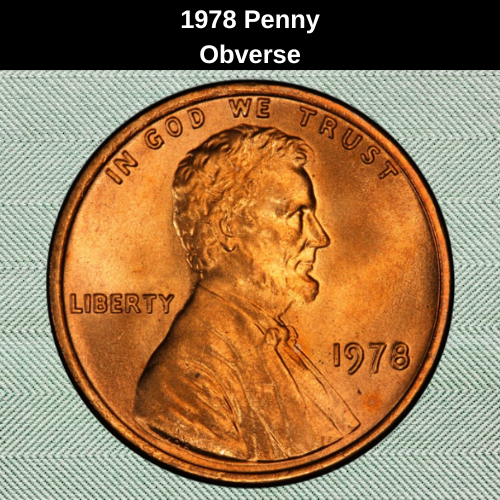
The obverse of the 1978 Penny features Abraham Lincoln, the 16th President of the United States, facing right. Behind him is the word “Liberty”, and above his head is the national motto “In God We Trust.” On the right side, just in front of his chest, you’ll find the mint date along with the mint mark, if present. Engraved on the shoulder cut-off are the initials “VDB”, which stand for Victor David Brenner, the coin’s original designer.
The Reverse of the 1978 Penny
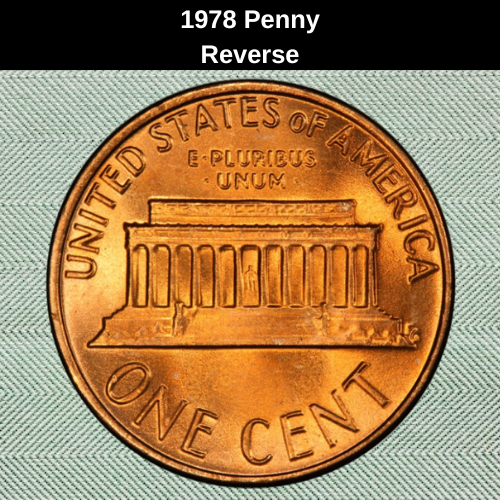
The reverse of the 1978 Penny displays the Lincoln Memorial, with even the statue of Lincoln visible between the two central columns—a fine detail often overlooked. On the right corner of the steps, you’ll find the initials “FG”, representing Frank Gasparro, the designer of the reverse. At the top of the coin are the inscriptions “United States of America” and the motto “E Pluribus Unum.” Along the bottom, it reads “One Cent,” indicating the coin’s face value.
Other Features of the 1978 Penny
The 1978 Lincoln Memorial Penny was composed of 95% copper and 5% zinc or tin, sometimes using a combination of both. Each coin weighed 3.11 grams and measured 19.05 mm in diameter (approximately 0.75 inches). The edge of the coin was smooth, meaning it had a plain edge with no reeding. Interestingly, as of 2023, it costs the U.S. Mint nearly 3 cents to produce just one penny—making it more expensive to make than its face value.
1978 Penny Grading
Today, the U.S. has six circulating coins, although the $1 coin is rarely used in everyday transactions. The penny stands out as the only copper-colored coin, and its value is determined using the Sheldon Grading Scale, which ranges from Poor to Mint State (MS).
In addition to numerical grades, copper coins like the 1978 penny are also categorized by color, which affects their market value. These color designations are:
- RD (Red) – the highest grade, indicating at least 95% of the original red luster remains
- RB (Red-Brown) – a mid-grade showing a mix of red and brown
- BN (Brown) or BRN – the lowest grade, showing mostly brown toning due to oxidation
Here’s a simplified breakdown of the Sheldon Scale:
| # | Grade |
|---|---|
| 1 | Basal State-1 |
| 2 | Fair |
| 3 | Very Fair |
| 4–6 | Good |
| 7–10 | Very Good |
| 12–15 | Fine |
| 20–30 | Very Fine |
| 40 | Extremely Fine |
| 50 | About Uncirculated |
| 60 | Mint State |
| 65 | Mint State (Gem) |
| 70 | Mint State (Perfect) |
Before estimating your coin’s value, it’s important to identify both its grade and color classification. Be sure to check our grading guides to help determine your coin’s precise condition—this is a crucial step in knowing its true worth.
1978 Penny Value Guides
As noted earlier, most 1978 Pennies were struck without mint marks. While collectors often assume they came from Philadelphia, these unmarked coins were actually produced at three different mints: Philadelphia, San Francisco, and West Point. Because these mints contributed to a combined mintage of unmarked coins, their high overall population keeps the value relatively low, especially when compared to the 1978-D (Denver) pennies, which are often worth slightly more due to their distinct mint mark and separate production run.
1978 No Mint Mark Penny Value
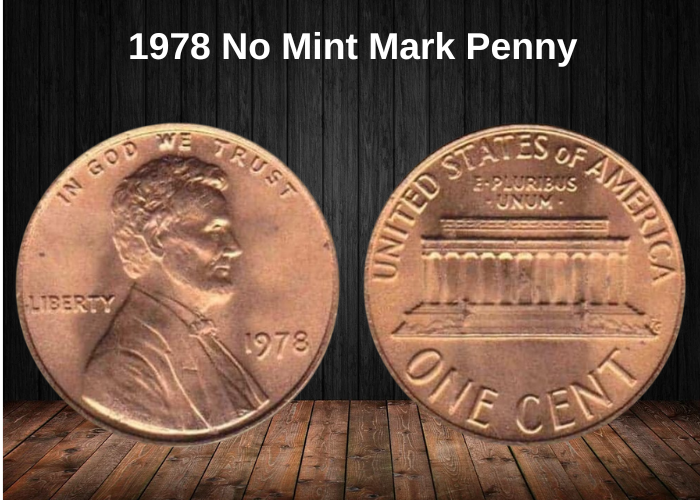
The total number of no-mint-mark 1978 Pennies struck was an astounding 5,558,605,000, making them extremely common and generally low in value. However, high-grade specimens can still fetch impressive prices.
- In May 2004, a 1978 MS 62 BN (Brown) sold for $661, while a MS 63 RB (Red-Brown) went for just $135 in a March 2018 eBay auction.
- In the Red (RD) category, a MS 67+ RD example sold for $4,259 in 2014.
- Since then, eight examples of MS 67+ RD have surfaced, bringing the value down to about $360 as of May 2025.
- A June 2019 sale recorded the same grade at $276, while two years earlier, it sold for $660.
- The true standout is the only known MS 68 RD, which carries an estimated value of $7,750 in May 2025.
1978-D Penny Value
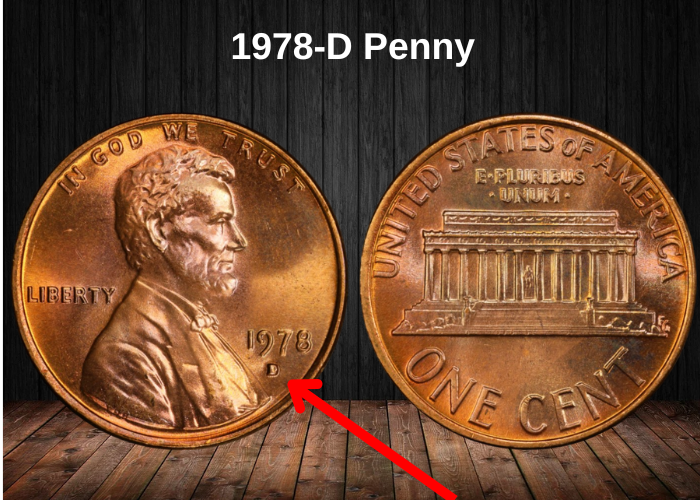
In 1978, the Denver Mint produced 4,280,233,400 pennies, all bearing the “D” mint mark. While these coins are common in circulation, high-grade examples can command respectable prices:
- A MS 66 BN (Brown) sold for $100 in a July 2021 eBay sale.
- A MS 67 RB (Red-Brown) fetched $205 in a 2020 eBay transaction.
- A MS 67 RD (Red) was sold for $546 back in 2008.
- Today, a MS 67+ RD is valued at approximately $1,700.
1978-S Proof Penny Value
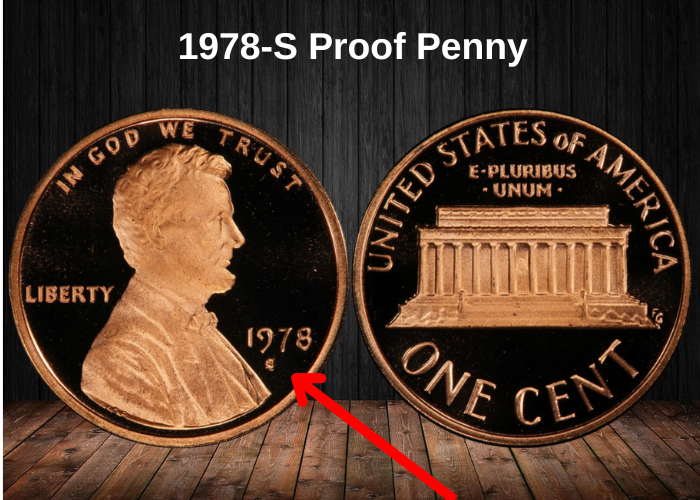
Proof pennies are specially crafted to represent the highest quality of a coin. A small number are reserved for archival purposes, while most are sold to collectors at premium prices. These proof coins come in three varieties: matte proof, reverse proof, and mirror-like proof. The mirror-like proof is the most prevalent and is the type used for the 1978 Penny, characterized by a reflective background (field) and a frosted raised design (device).
The coin’s brilliant shine is achieved through a process that involves burnishing the blank planchet prior to striking and polishing the die with a horsehair brush. During burnishing, the blank is tumbled in a vat filled with tiny 6mm stainless steel beads to smooth its surface. The frosted texture on the design and lettering results from parts of the die being treated with acid (pickling). On newer coins, this frosted effect is produced by precise laser etching.
For older proof coins, the acid frosting on the die gradually wears down as more coins are struck, causing the contrast between the mirror-like field and frosted device to fade. The earliest coins typically exhibit the strongest contrast, earning a Deep Cameo (DCAM) or Ultra Cameo designation by grading companies like NGC, usually limited to the first 50 to 100 coins produced. Subsequent coins tend to have a softer contrast and are simply graded as Cameo or regular proofs, with color grades of red, brown, or a mixture.
In 1978, the San Francisco Mint produced 3,127,781 proof pennies with the S mint mark. Most of these were laser-frosted, resulting in a majority receiving the DCAM grade. This widespread DCAM grading has reduced their market value.
- For example, a PR 70 DCAM coin sold for $4,313 in June 2008.
- Today, with over 60 PR 70 DCAM coins certified by PCGS, their value has decreased to about $2,150.
- Additionally, there are over 6,000 PR 69 DCAM graded coins, which now typically sell for around $14.
Rare 1978 Penny Error Coins
Coin errors can significantly increase a coin’s value. The most frequent errors include hub doubling, wrong planchets, and clips. Numismatic references list about 20 to 25 major error types, with the most valuable being First Strike (FS) errors—those discovered within 30 days of a coin’s initial release. Let’s explore the value of some notable 1978 Penny errors.
1978 Penny Doubled Die Obverse (DDO)
Hub doubling happens when the die shifts slightly between impressions from the hub, causing a second, offset image to be impressed. This can occur on either the obverse (heads) side (DDO) or the reverse (tails) side (DDR). More extreme cases include hub tripling or quadrupling. These errors appear on every coin produced by that specific die, making them recognized varieties. For example, a 1978 Penny graded MS 65 with a DDO error is valued around $20.
1978 Penny Struck on a Dime (Double Denomination Error)
Coins are stamped on blank metal discs called planchets, fed between the dies for imprinting. Occasionally, a previously struck coin can accidentally re-enter the press, receiving design details from a different denomination. In this case, a penny mistakenly struck on a dime planchet results in a double denomination error. In 2006, an MS 64 Double Denomination coin sold for $1,035.
1978 Penny Struck 10% Off-Center with 15% Straight End Clip

Planchets start out as a coiled metal sheet before being flattened and punched into round discs by the blanking machine. The leftover metal, full of holes where planchets were cut, is usually sent for recycling. Occasionally, a coin is mistakenly struck on one of these remnant pieces, resulting in a coin with clipped edges where the holes were. In one notable case, a 1978 penny with such a clip error combined with a misalignment sold for $430 in MS 64 BN condition.
1978 Penny Struck 45% Off-Center
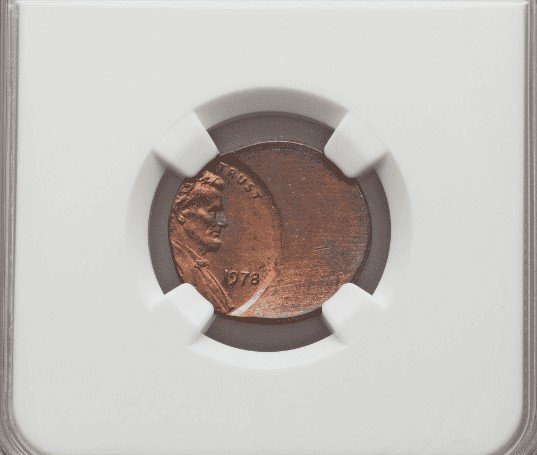
For a coin to be struck correctly, the planchet must be perfectly centered between the dies. However, because the press produces hundreds of coins per minute, sometimes the blank is misaligned, resulting in an off-center strike error. This error leaves a portion of the coin’s surface blank or missing design.
- A 1978 Penny with a 45% off-center strike, graded MS 63 BN, sold for $105.
- A 1978-D Penny with a 70% off-center strike, graded MS 64 RB, fetched $175.
1978-D Penny Double Struck 80% Off-Center
Sometimes a coin gets restruck as it exits the press, causing overlapping designs and even a distorted shape. In this example, the second imprint was 80% off-center, creating an extra Liberty image on the front and a distorted denomination on the back. This coin, graded Uncirculated Details RB due to damage, sold for $170.
1978-D Penny Repunched Mint Mark (RPM)
On early coins, the mint mark was added last by hand using a manual puncheon, so mistakes like repunched mint marks can occur. This shows as traces of a previous mint mark underneath, sometimes sideways, overlapping, or thicker than normal. An MS 65 RPM 1978-D penny is valued at around $30.
1978-D Penny Cud Die Break
As dies wear out, they can crack or chip, causing excess metal to fill gaps on the coin’s surface—known as a cud die break. This looks like a small scoop or lump on the coin. In MS 63 RB, a 1978-D penny with this error sold for $160 in 2021.
1978-D Penny 40% Brockage Obverse
The feeder fingers in the press push blanks between dies, but sometimes a blank sticks to the die, blocking the next coin—this creates a die cap error and a brockage error on the blocked coin. Here, 40% of the coin’s surface was covered by the die cap. A 1978-D penny MS 62 RD with this error sold for $125.
1978 Penny Struck Through Capped Die
Another example of a brockage error occurs when a coin is struck through a capped die. This causes a blurry impression of the obverse design with faint hints of the reverse visible on the same side. A 1978 penny graded MS 65 RD with this error is valued at $65.
For context, a capped die coin is often a mirrored penny, meaning it shows an inverse image of the obverse on both sides, lacking the tails design entirely.
Where to sell your penny?
Now that you know the value of your penny, you might be wondering where to sell it. Don’t worry: here’s a guide to some of the best online platforms where you can easily sell your coins, along with their advantages and disadvantages.
Discover the best platforms for selling coins online (pros and cons).
1978 Lincoln Penny FAQ
1. What is the general value of a 1978 Lincoln penny?
Most 1978 pennies are worth face value (1 cent) in circulated condition. Uncirculated coins graded MS60 to MS65 can fetch between $0.50 and $5, with higher grades and better eye appeal commanding a premium.
2. Which mints produced the 1978 penny, and how many were minted?
- Philadelphia (no mint mark): approximately 3.3 billion
- Denver (D mint mark): approximately 3.6 billion
- San Francisco (S mint mark, proof only): about 8.3 million
The large mintage numbers make this a very common date.
3. Are there any significant errors or varieties for the 1978 penny?
There are no famously rare errors, but some known varieties include:
- Repunched Mint Marks (RPMs)
- Minor die cracks or die breaks
- Off-center strikes
- Planchet flaws such as clipped or laminated planchets
These errors may add value, usually from $10 to $100 depending on severity and grade.
4. What is the metal composition of the 1978 Lincoln penny?
The 1978 penny is made of 95% copper and 5% tin and zinc, weighing about 3.11 grams. This copper alloy was standard until mid-1982, after which pennies switched to mostly zinc.
5. Were there any design changes for the 1978 penny?
No. The 1978 penny continued with the classic Lincoln design:
- Obverse: Abraham Lincoln’s portrait by Victor David Brenner
- Reverse: Lincoln Memorial by Frank Gasparro
This design was unchanged from 1959 to 2008.
6. How do 1978 proof pennies differ from circulation strikes?
Proof pennies, minted only at San Francisco (S mint mark), have mirror-like surfaces and sharper details compared to circulation strikes. Proofs often command higher prices, especially in higher grades, ranging from $2 to $20+.
7. What tips can help collectors identify valuable 1978 pennies?
- Examine coins for RPMs or subtle doubling under magnification.
- Check for die cracks or breaks.
- Look for exceptional luster and color (Red designation) on uncirculated coins.
- Professional grading by services like PCGS or NGC can confirm value and authenticity.


















































